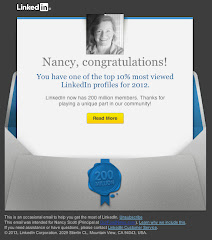This afternoon, I tuned into the International Freelancer's Day Conference hosted by Ed Gandia, founder of the International Freelancer's Academy. One of the presenters, Erik Vonk described in detail why he believes society-at-large has now entered the "Era of Dynamism," during which people worldwide will begin to work for themselves.
Here are some key points from Vonk's presentation.
Today's worker has become global and independent.The way we used to work was rigid and carries significant liabilities. Today no one believes in job security or job loyalty. Temporary enterprise is flexible, talent-centric, and networked. Exchanging competencies for income is no longer tied to a job. In 2011, 59% of workers had been employed in the same place an average of only four years. In short, there is nothing permanent about work anymore.
Migration-enabling developments are prevalent all over the world.
There is an uncommon transference of wealth globally -- for example, we all buy oil from "somewhere else." This new "transference" creates dynamism and fluidity.
Todays modern temporary enterprise is platform agnostic.
In society, we are beginning to see that on-demand work arrangements have evolved from being tolerable to being desirable to being aspirational.
1. The "position" does not define work platform. Agreements today are based on supply and demand. The need for certain competencies within an organization determine the work platform.
2. Any eligible position can be filled by a contractor.
3. Megatrends promote this dynamic situation.
A number of realities define the work world today, including these often misunderstood myths about taxes and business method.1. Myth: Contingent [temporary] work produces tax savings. Reality: The revenue value of an independent contractor to the IRS/government is the same as for employees. An organization saves money by using independent contractors, but the IRS/government gets the same money no matter the work status of the worker.
2. Myth: A payrolled contractor has independent status. Reality: An independent contractor employed by a third party [for example, a temp agency] does not have independent contractor status.
3. Myth: Self-incorporation [being "incorporated"] leads automatically to tax compliance. Reality: The rules that surround compliance lie with the IRS or with individual states, not with the "incorporation" of a particular business. Nevertheless, incorporation does act as a liability shield for the independent contractor and also, incorporation may make it possible to change from an employee status to a vendor status.
What does/will "Obamacare" mean to independent contractors?
1. Provides access to health insurance
2. Creates federal health insurance requirements for everyone.
3. Creates health insurance exchanges, places independent contractors can go to buy state-operated policies.
The individual mandate means that -- as of 2014 -- every individual must be enrolled in a health plan. Those not covered will pay a penalty through tax returns [Note: there will be exemptions for those below the poverty line and certain exemptions based on religious rules can be sought.]
The solo practitioner may live in a state that offers coverage to a small business or as individual. That capability varies among states.
How can we freelancers thrive?
1. Inform prospective clients about tax realities and be informed with tax, legal, and business issues.
2. Play into the momentum. The desire is there. Megatrends are pushing the tsunami of change and influencing the role of work in the society toward independence. Be informed and help others to understand.
3. The last barriers are crumbling: retirement options (401Ks, IRAs); health coverage (Obamacare, regulatory initiatives, the marketplace already underwriting plans); banking and insurance; IRS (villianization of independent workers is waning through efforts of entities like the Freelancer's Union); more examples of progressive employers (IBM, for example has "liquid" players, Microsoft modern thinking is prevailing).
The best advice is: Keep your options wide open.
1. Worldwide companies are looking to replace fixed costs with variable expenses. They want access to talent pools.
2. Continue to think from the organization's perspective. increasingly, the "business plan" -- not historic work conventions -- decide who will be employed and who will be contracted.
3. Do not be guided or distracted by fear-mongering: Get good advice and move ahead confidently.
-- scrubbed by MarketingBrillo
Erik Vonk is an internationally recognized expert in the field of freelancing and independent contracting. As the architect of the staffing contract between Randstad Staffing Services and the Atlanta Olympic Committee, he orchestrated the provision of all 16,000 paid personnel for the Centennial Olympic Games in 1996. This is still the largest single supplier contingent workforce arrangement on record. He is the author of the book “Don’t Get a Job, Get a Life” (2000), which makes the case for replacing outdated employment conventions with "on demand" work platforms. Follow him on Twitter: @erikvonk.



